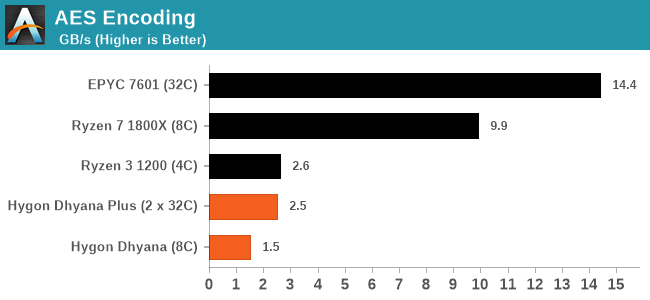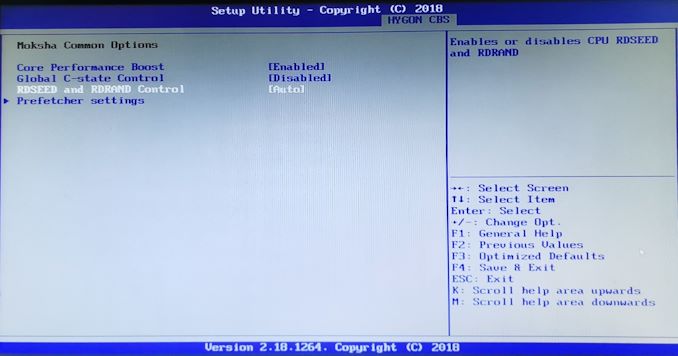Testing a Chinese x86 CPU: A Deep Dive into Zen-based Hygon Dhyana Processors
by Dr. Ian Cutress & Wendell Wilson on February 27, 2020 9:00 AM ESTHygon CPUs: Chinese Crypto, Different Performance
The big overriding question is about what exactly has changed with these processors compared to the standard Ryzen and EPYC CPUs. To say that they are rebadged processors, as some have suspected, is completely incorrect – we can tell this alone by the different cryptography engines provided by the Linux kernel updates. But we also detected other differences.
By and large, as we could determine, the core layout is identical, with the same cache sizes, TLB sizes, and port allocations – there were no differences at this fundamental level. The CPU still offered 64 KB 4-way for the L1 instruction cache, 32 KB 8-way for the L1 data cache, 512 KB 8-way for the L2 cache, and 8 MB 16-way for the L3 cache, identical to the Zen 1 core. TLB entries are as follows:
- L1D + L1I: 4K/2M/1G 64-entry
- L2D: 4K 1536-entry 6-way, 2M 1536-entry 3-way, no 1G
- L2I: 4K/2M 1024-entry 8-way, no 1G
Memory access times are 4 cycles for L1, 12 cycles for L2, and 37-40 cycles for L3. Memory latency was measured at 284-307 cycles.
L1 read speeds were measured around 32 bytes per clock (805 GB/s total, ~100 GB/s per core), while write speeds were measured around 16 bytes per clock (408 GB/s total, ~51 GB/s per core). DDR4 Memory speed for the 8-core gave 38.5 GB/s for reads and 35.8 GB/s for writes.
Cryptography Changes
For the cryptography changes, these are detailed in the Linux kernel updates. The updates revolve around AMD’s secure encryption for virtualization features, or SEV. Normally with an EPYC processor, SEV is governed by the cryptography protocols defined by AMD, in this case RSA, ECDSA, ECDH, SHA, and AES. In order to generate the right keys, SEV uses these methods. However, in the Hygon Dhyana designs, SEV is built to use algorithms known as SM2, SM3, and SM4.
As stated in the updates, SM2 is based on elliptic curve cryptography, and requires additional private/public key exchange. SM3 is a hashing algorithm, similar to SHA-256, and SM4 is a block cipher algorithm, similar to AES-128. Additional commands are placed into the Linux kernel in order to support the extra functions these algorithms need. In the notes it states that these algorithms were successfully tested on Hygon Dhyana Plus (presumably the big CPU) processors but they were also successfully tested on AMD’s EPYC CPUs.
Slowing Down Some Instructions
The biggest update to the design we were able to determine is in the instruction throughput. We don’t think that this difference between Dhyana Plus and EPYC has been mentioned before, and we did extra checks to make sure our software was displaying the right data, but put simply some instructions have been purposefully made slower. This has some rather serious implications, especially depending on when it occurred in the pipeline.
What we think is the case is that in order for AMD to export its SoC design, it had to also share microcode relating to how the CPU interprets instructions, and it was told to slow down certain key instructions (or disable them altogether) in order to make the arrangement with the joint venture and China work.
In our testing, we found that while integer performance is similar between Hygon and EPYC, certain floating point instructions, namely DIV and SQRT, are not pipelined in the Hygon CPU. This means throughput and latency is reduced. A lot of simple MMX/SSE instructions have reduced throughput:
| Instruction Throughput Differences | ||
| AnandTech | EPYC Naples |
Hygon Dhyana |
| ADD/SUB | 2 per clock | 1 per clock |
| CMP/MULP* | 2 per clock | 1 per clock |
| ADDSUBP* | 2 per clock | 1 per clock |
| RCP*/RSQRT* | 1 per clock | 0.5 per clock |
| BLENDW | 3 per clock | 2 per clock |
| PMIN/MAX* | 3 per clock | 2 per clcok |
| PAND/ANDN/OR/XOR | 4 per clock | 2 per clock |
| MOVs | 4 per clock | 2 per clock |
All of these instructions are pretty important for even basic tasks. By limiting the simultaneous throughput of these instructions, it means that these CPUs cannot compute code that can be parallelized as fast, ultimately decreasing performance.
Perhaps the biggest change however was one that even differed between the server ‘Dhyana Plus’ processor and the consumer ‘Dhyana’ version. Random number generation, which is a key backbone in a lot of stochastic and financial processes, is severely reduced on the Dhyana Plus. The key instructions, RDRAND and RDSEED, have various reasons for being slow/fast. Here’s the comparison:
| Instruction Latency Differences | |||
| AnandTech | Zen 1 Desktop |
Hygon Dhyana |
Hygon Dhyana Plus |
| RDRAND | |||
| 16-bit | 1200 clocks | 1100 clocks | 800 clocks |
| 32-bit | 1200 clocks | 1100 clocks | 800 clocks |
| 64-bit | 2365 clocks | 2125 clocks | 1520 clocks |
| RDSEED | |||
| 16-bit | 1200 clocks | 1100 clocks | 12000 clocks |
| 32-bit | 1200 clocks | 1100 clocks | 12000 clocks |
| 64-bit | 2365 clocks | 2125 clocks | 27100 clocks |
That’s quite a difference, especially in RDSEED. We saw that RDSEED, the seed generation to help spawn random number algorithms, is over 10x slower on the server chip, and RDRAND, used for actually generating hardware based random numbers, is faster than standard Ryzen – moreso on the server chip. Interestingly enough, the same delays for RDSEED for the server chips are also seen on Ryzen Mobile and Ryzen Desktop APUs.
For RDRAND, having a faster random number generator can be indicative of two things: either it is actually faster, or the random algorithm has a lower periodicity, i.e. the point at which an algorithm wraps on itself. The best pseudo-RNG have the largest periodicity, so in this case the RDRAND is fast leads us to conclude that the periodicity is low, leading to lower quality random numbers.
For RDSEED, the fact that this is 10x slower is a little different. RDSEED is meant to take information from the various sensors on board and output a random value to initialize the RDRAND – it should only get called once per periodicity. A slower RDSEED either means its taking data from more sources (a good thing), or it’s being slowed down on purpose (a bad thing).
In actual fact, RDRAND and RDSEED can be enabled/disabled in the BIOS of our Dhyana Plus system.
It’s amusing that this menu is called ‘Moksha Common Options’. Moksha being a word commonly associated with ‘enlightenment’ or ‘release’. This is either a clever word play, or someone digging out a non-contextual old Chinese to English dictionary in translation.
When it comes to AVX and AVX2 performance, even though the CPUs were able to identify themselves as having AVX and AVX2 support, trying to actually measure these instructions failed – in our instruction dumps, they were listed as ‘supported, disabled’. When it comes to supported features, Zen 1 typically lists AESNI, SHA, CLMUL, FMA4, BMI and BMI2 as supported instructions - none of these instructions are supported on the Hygon CPUs.
For things like AES, we have a direct benchmark for these, and the fact that these CPUs do not support AES means that we get a tanking in performance:

It should also be noted that the typical methods for finding the power consumption on AMD CPUs by probing registers also failed here. These seem to be removed from the CPU altogether.











133 Comments
View All Comments
anarekist - Thursday, February 27, 2020 - link
that was a great and detailed article, very much appreciated.Notmyusualid - Sunday, March 1, 2020 - link
I very much enjoyed it also.PeterCordes - Thursday, February 27, 2020 - link
RDRAND isn't just a PRNG, it's still supposed to be based on true randomness. https://en.wikipedia.org/wiki/RDRANDIt being faster doesn't necessarily indicate lower quality. See https://crypto.stackexchange.com/questions/29894/a... for some hardware details on the circuit AMD uses to turn analogue noise into digital randomness. (Apparently sampling asynchronous ring oscillators, and feeding that through some digital mixing functions (e.g. a hash) to "whiten" the result. Intel's design is similar, but based on sampling thermal noise.)
RDSEED is merely even higher-quality randomness, suitable for seeding a PRNG instead of using directly. (It does not, as you mis-state, seed RDRAND. It's just a differently-processed way of pulling data from the same true HW randomness). Also unlike Linux /dev/random, it doesn't collect randomness from "various sources" into an entropy pool; my understanding is that all the randomness comes from a true HW RNG.
Perhaps they had to redesign (for export-control reasons) the digital mixing functions that "whiten" the hardware randomness? A much more conservative approach for RDSEED could easily explain it being much slower, like if they didn't want to trust AMD's design not to have NSA back-doors. Or simply a lower-effort or less skilled redesign by a 3rd party that wasn't part of the original design could account for it.
AMD Zen had some RDRAND bugs (like always returning -1 in some conditions) that were fixed by microcode updates; perhaps Hygon fixed that in hardware instead of microcode if there was any problem that AMD used to need to work around?
Duto - Thursday, February 27, 2020 - link
Good job in calming the concerns of many, and we appreciate it. However, nothing can change the fact that valuable American technology was transferred to a foreign and potentially hostile power, who is led by a dictatorship that violates #humanrights on a daily basis, yes continental China. Equally problematic is the fact that for a few dollars, AMD shoots on its feet, no turning back on that. It is evident that such disgrace took place under a very weak administration at home, in the current administration watch that wouldn’t happen, ever. So glad they close the deal for good!sarafino - Thursday, February 27, 2020 - link
"Equally problematic is the fact that for a few dollars, AMD shoots on its feet, no turning back on that."How exactly did they do that? They shared designs based on their older (outdated), slower Zen core. As you can plainly see in this review, Hygon's processors are not exact setting the world on fire in terms of performance. They're slower than 3 year old Zen 1 processors and significantly slower than any Zen 2, or soon, Zen 3 processors. You're making a mountain out of a mole hill.
Oxford Guy - Friday, February 28, 2020 - link
Perhaps, but also consider that some of the world's leading supercomputers were made with Piledriver CPUs.Journalists like Hruska never miss an opportunity to mock AMD for its "construction core" debacle but when they talk about the poor performance of the parts they never mention how many supercomputers used them successfully. Sometimes being cheap and adequate is enough, especially when paired with high-performance GPUs.
29a - Monday, March 2, 2020 - link
There is one in the Top 500 and it's ranked 481.Retycint - Thursday, February 27, 2020 - link
I wouldn't be so sure that the "transfer of American tech to a foreign hostile power" won't happen under the current administration, given that they seem to have a special affinity for the Russianss.yu - Sunday, March 1, 2020 - link
>they seem to have a special affinity for the RussiansNot "they", but "he".
What exactly has he transferred to Russia that hasn't been stopped by congress?
jospoortvliet - Monday, March 2, 2020 - link
Pretty much Syria, for one... and if he wasn't dragging his feed on support for Ukraine perhaps it would be free of russian soldiers by now as well.I know, it isnt intellectual property hehe